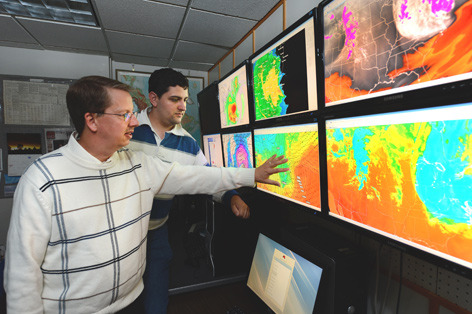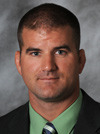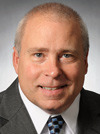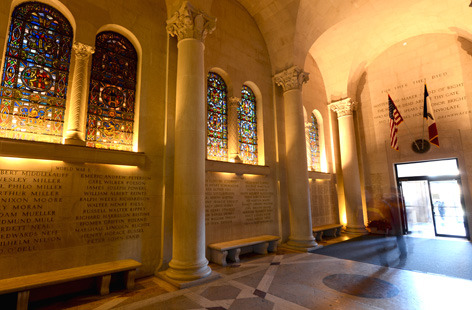Deconstruction at Curtiss Hall

Demolition of the two levels below the Curtiss Hall auditorium, in preparation for the student-centered Harl Commons, is about 75 percent complete and should wrap up before the semester break. Project manager Kerry Dixon-Fox said about three-fourths of the commons project is demolition and cleanout work to open up the space.
When Harl Commons is completed next summer, it will feature a student lounge area, coffee counter, meeting room and a balcony suite of offices for the college's Agricultural Entrepreneurship Initiative. The project also adds a ground-level entrance to the east side of Curtiss Hall and a larger elevator that will service every level of the building. Photo by Bob Elbert.
Four priorities guide planning for FY14 and beyond
Four overarching priorities will guide both effort and budget planning at Iowa State over the next several years. President Steven Leath first shared the four with his budget cabinet in September and the University Budget Advisory Committee last week. If you were taking notes during his Sept. 14 installation address, you heard them in there, too.
Work has begun to develop budgets for the fiscal year that begins next July 1, but the final product will rely noticeably on two variables: state appropriations and the size of the student body. University leaders have proposed zero to small tuition increases next year, as well no increases to mandatory student fees.
Using the current strategic plan as a starting point, Leath identified these priorities:
- Maintain academic excellence. For example, this might include efforts to keep college affordable for students, strengthen the student experience at Iowa State and retain high-quality faculty.
- Enhance the university's basic and applied research footprint. Examples include the new Presidential Initiative for Interdisciplinary Research and expanding opportunities to collaborate with external partners on applied research.
- Promote economic development. Examples include expanding the ISU Research Park to assist the state's efforts to attract key industries to Iowa, and improving the university's economic development framework to make it more transparent and flexible.
- Improve the campus environment. Examples could include everything from initiatives that emphasize diversity and employee wellness to campus beautification projects.
Assistant vice president for financial planning and budgets Dave Biedenbach said the priorities will influence operating budgets, building projects and hiring decisions during the next few years.
Budget planning
The university's senior vice presidents -- for academic affairs, business and finance and student affairs -- are using these university priorities to set their own division priorities and guide their budget planning. Their preliminary budget plans for FY14 are due to Leath in January, followed by updates in April and final or near-final budgets in May.
State funding request
On behalf of Iowa State, last month the state Board of Regents requested a 2.6 percent incremental increase to the university's operations appropriations for FY14. That's about $4.4 million for the general university and about $2.5 million in total for eight units or programs that receive a direct appropriation (such as the Agriculture Experiment Station, Leopold Center or the Veterinary Diagnostic Lab). The percentage is equivalent to the projected median of the Higher Education Price Index for FY14.
Additionally, Iowa State will ask for $7.5 million in one-time state funding to support additional research efforts in the bioeconomy. The funds would support world-class research facilities, new research programs and the preparation of additional grant applications.
The board asked for permanent funding for the $3 million Regents Innovation Fund (Iowa State's share is $1.05 million) and continued funding ($4.7 million) for the three-university STEM initiative. And the board will ask for $39.5 million to set up a tuition grant program for in-state undergraduate students with financial need who attend one of the three regent universities.
Included in the board's capital (building) funding request to the state for FY14 is $5 million to begin planning for a new biosciences building at Iowa State.
The governor and Legislature use these requests in building their proposed state budgets.
ISU meteorologists help Cyclones play it safe

Professor Bill Gallus and graduate student Tim Marquis keep a watchful eye on the weather when the Cyclones are playing at home and outside. Photo by Bob Elbert.
It's a pregame favorite at Jack Trice Stadium. The vintage black-and-white test pattern on the scoreboard signals a Cyclone weather alert. "Strong storms are approaching the stadium," the loudspeaker blares. The announcement continues, urging opposing fans to seek shelter immediately, and the home crowd roars appreciatively.
If only they knew, Cyclone fans might make a little noise for some real storm watchers in their midst -- the Iowa State meteorologists who spend game week and, occasionally, game day poring over weather maps, figuring out what's going to chill, heat, drench or strike Jack Trice Stadium.
Under the guidance of professor of geological and atmospheric sciences Bill Gallus, graduate students Tim Marquis and Brian Squitieri prepare forecasts for Cyclone football, soccer, softball and track. All three are trained meteorologists who volunteer their time and expertise in the interest of game day safety.
Early surveillance
They're on the job at least a week before each game, eyeing weather models to see if anything blowing into Ames could be severe enough to threaten fans and players. Lightning is the most common threat at outdoor venues, but the meteorologists look for all kinds of severe weather, including tornadoes.
Assistant athletics director for operations Nick Britton and ISU deputy chief of police Rob Bowers welcome the meteorologists' help, which began about a year ago at Marquis' suggestion. Currently an M.S. candidate at Iowa State, Marquis did his University of Oklahoma undergraduate thesis on weather accidents at large outdoor venues. The work led him to believe that many weather tragedies could be prevented with more warning time.
When Marquis and Gallus offered help in tracking weather prior to Cyclone contests, Britton and Bowers readily accepted. While the ISU officials have long used, and will continue to use, the National Weather Service and other forecasting services, they liked the idea of trained professionals giving special attention to Ames.
Unsettling scenario
An example of that special attention occurred in mid-October when the Iowa State weather trackers noticed that a potential tornado-producing system appeared to be on a collision course with the Oct. 13 Kansas State game in Jack Trice Stadium. The game was more than a week away, but all the major weather models appeared to lock on the same unsettling scenario.
Marquis alerted Britton, and contingency planning began. All week, the meteorologists watched the weather while athletics staff, police and other university personnel discussed everything from communication plans to procedures for evacuating people in the stadium area.

Britton
"We don't ever want to get blindsided," Britton said. "You prepare for the worst and hope for the best."
Fortunately, in the case of the K-State game, it turned out to be the latter. The grim weather outlook began to brighten as the weekend approached and, despite a rainy Saturday morning, the game was played on time and under relatively clear skies.
Still, game day found the ISU meteorologists hunkered down in Agronomy Hall labs watching radar for storm-producing lightning and predicting rainfall amounts. On hand were several undergraduate students in the department of geological and atmospheric sciences.
Good for students
"I wanted undergraduates here to observe what goes into warning forecasts," Marquis said.
The weather monitoring program's potential for yielding learning experiences for students is important not only to the academics involved, but to those in the athletics and police departments.

Bowers
"A big plus of the partnership is the benefits to students in Iowa State's meteorology program," Bowers said. "It provides the grad students resume-building experience and valuable learning opportunities for undergrads."
"Meteorology can use it as a teaching mechanism for the students," Britton said. "That's why we're here -- for the students."
All of those involved in the weather-monitoring partnership are quick to point out that final decisions on managing outdoor Cyclone events rests with the athletics department and police.
"Meteorology provides us with information and guidance so we can make decisions based on science and data," Bowers said.
"It's really just some extra information that goes into their toolkit to help them decide what call to make," Gallus said.
In fans' hands
ISU officials stress that fans are an important part of the play calling when it comes to weather safety. They urge those attending games outside to pay attention to the weather and heed warnings.
"Ultimately your safety is in your own hands," Gallus said. "Nobody else can make you 100 percent safe when it comes to weather."
Save more money for retirement in 2013
The Internal Revenue Service has set higher contribution limits for 403(b) plans in 2013, giving Iowa State employees an opportunity to save a little more for their retirement nest eggs.
Employees age 49 and younger may add an additional $500 in voluntary contributions to their 403(b) plans next year, for a maximum of $17,500. Employees age 50 and older may add an additional $5,500 (same as 2012) to their 403(b) plans in 2013 on top of the $17,500. This contribution is considered a "catch up" for those employees who are nearing retirement.
Why the increase?
"There's an inflation component," said Ann Doty, retirement information consultant in human resource services. "Other governmental programs such as Social Security are periodically adjusted for inflation and retirement plans are also adjusted."
Who is eligible?
Iowa State employees with a budgeted salary may voluntarily contribute extra funds from their paychecks for retirement; hourly employees and post-doctoral students are not eligible. For more information, visit the HRS website.
What action is needed?
If you already are voluntarily saving additional funds in your 403(b) account and you want to change that amount for 2013, you will need to update the elective payroll reduction agreement form (PDF). If you wish to start saving additional funds, you first must notify one of the four companies ISU sponsors. They are TIAA-CREF, VALIC, MetLife or Ameriprise Financial. Or, contact Doty, 4-4521, who will assist you with completing the correct forms.
Council rep areas getting another look
Representation areas for the Professional and Scientific Council could change, members learned at their Nov. 1 meeting. A motion to divorce the combined representation for P&S employees in the U.S. Department of Energy's Ames Laboratory and IPRT (Institute for Physical Research and Technology) opened the door to further changes.
Currently, council members represent one of six organizational areas:
- Academic and research
- Extension
- Business and finance
- Student affairs
- IPRT/Ames Lab
- President's office
The motion that proposed separating the IPRT/Ames Lab organizational area sought to mirror a 2007 change that established independent directors for the two entities.
Senior vice president and provost Jonathan Wickert recommended a reevaluation of the current structure with an eye to the current university model. Dick Pfarrer, chair of the council's representation committee, withdrew his group's motion in order to "revisit the organization of the representation areas."
Pfarrer indicated a new motion on representation areas would be introduced and likely voted on at the council's Dec. 6 meeting.
Other business
- Concern over low travel reimbursement rates will be sent to a council committee for development of a resolution. Past president Dan Burden said employees are reporting that current rates are inadequate for coverage of travel expenses.
- A professional development day for all P&S employees is being planned for April 2.
Updated FAQ offers more details on research funding initiative
If you plan to seek funding through the Presidential Initiative for Interdisciplinary Research, check the online FAQ for recent updates.
New on the FAQ
The FAQ has been expanded in response to feedback and questions that came up at two recent open forums on the initiative. New entries in the revised FAQ:
- Include additional details on the kinds of expenses allowed under the initiative. For example, the initiative allows expenses for non-tenure-eligible research faculty salaries and some administrative support, but doesn't allow expenses for faculty summer salaries. Grad student support is an allowed expense on smaller proof-of-concept grants, but not on pursuit funding grants.
- Advise grant applicants to work with department or college administrators to determine "salary buyouts." Buyouts will allow individuals to temporarily reduce teaching loads and devote more time to the research initiative.
Background on the initiative
The initiative, announced by president Steven Leath in September, will help researchers take on large, multidisciplinary issues that are hard to pursue without assistance. The grants will provide pursuit funds -- dollars that don't support the research itself, but rather the preparation of large-scale research funding proposals.
Two types of funding are available under the research initiative:
- Pursuit funding grants. These multidisciplinary, multi-institutional grants will fund projects that are large in size and scope and require significant input of resources. Up to three teams will be selected for a large grant award. Each selected team could receive up to $500,000 annually for three years.
- Proof-of-concept grants. These grants will fund smaller projects that are limited in scope, higher risk or require proof of concept before investigators can pursue larger funding. One-time, one-year awards, ranging from $50,000 to $100,000, will be given to up to three teams.
Timeline
The first step in applying for either the pursuit funding or proof-of-concept grant is to submit a white paper by Dec. 1. From the white paper submissions, some teams will be invited to prepare full proposals by Feb. 1, 2013. Final awards will be announced by March 1.
Leading the review process will be the President's Committee for Institutional Excellence, with assistance from subject experts in industry, higher education and government laboratories.
Documents and forms on the initiative are linked from the FAQ site.
Two World War II heroes to be honored at Gold Star Hall ceremony

An article in the Summer 2011 issue of the alumni association's magazine initiated a chain of events that stretches from World War II all the way to the university's Gold Star Hall ceremony next week.
Two readers of the Visions article, "Honoring Our Fallen Heroes," came forward with stories about two former Iowa State students who died in military service during World War II. Although their names were previously engraved on the walls of the Gold Star Hall -- the war memorial in the university's Memorial Union -- their stories had not been honored at Iowa State.
The lives of these two brave pilots -- both bona fide heroes -- will be remembered during the ceremony at 3:15 p.m. Monday, Nov. 12, in the Great Hall. The ceremony is open to the campus community.
"There's some urgency for us to tell the stories of World War II honorees while we can learn firsthand from their service buddies and families," said Kathy Svec, ceremony coordinator and retired ISU Memorial Union marketing director. "It's very cool when you get family members who had an extensive interest in their relatives who served."
During the ceremony, each soldier's life will be honored through personal stories and photos. Svec and Larry Huisman, retired Memorial Union finance director, compiled the stories, using biographies and materials provided by the families.
Don Beerbower, a pilot from Hill City, Minn., died while bombing German airfields in France. A virtuoso triple ace, his superiors considered him to be one of the greatest fighter pilots in the European theater.
Paul Sailor, Wadena, Minn., saw the Visions article and responded with a letter outlining Beerbower's life and heroism. He had grown up hearing stories about Beerbower from his father, a childhood friend of the pilot. Sailor is the author of The Oranges are Sweet, a book about Beerbower and the men who served with him in the 353rd Fighter Squadron.
Sailor and Beerbower's daughter Bonnie and her family of Cohasset, Minn., will attend the ceremony on Monday.
Allan Ewoldt's family -- all Iowa State alums -- also responded to the Visions article. Ewoldt flew 33 missions in just three and a half months during a major campaign in Sicily and Italy. He will be honored thanks to extensive information provided by the family.
Ewoldt's nephew, Homer Ewoldt of Spencer, and his family also will attend the ceremony.
In addition to the soldiers' stories, the Gold Star ceremony will include an Army ROTC color guard and brief remarks by university and military representatives.
